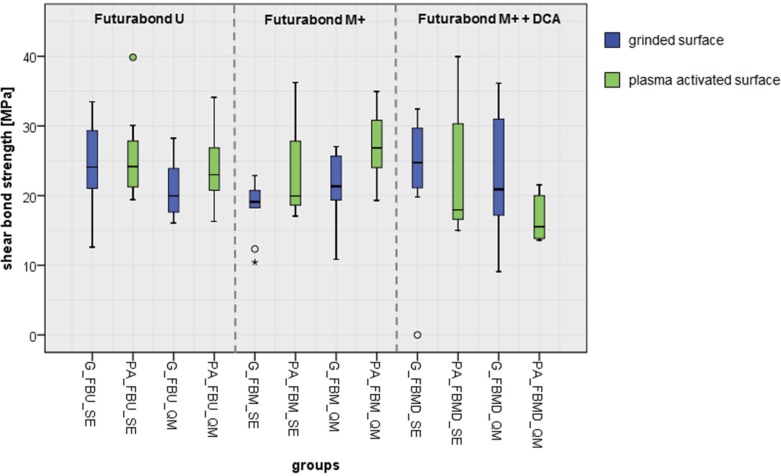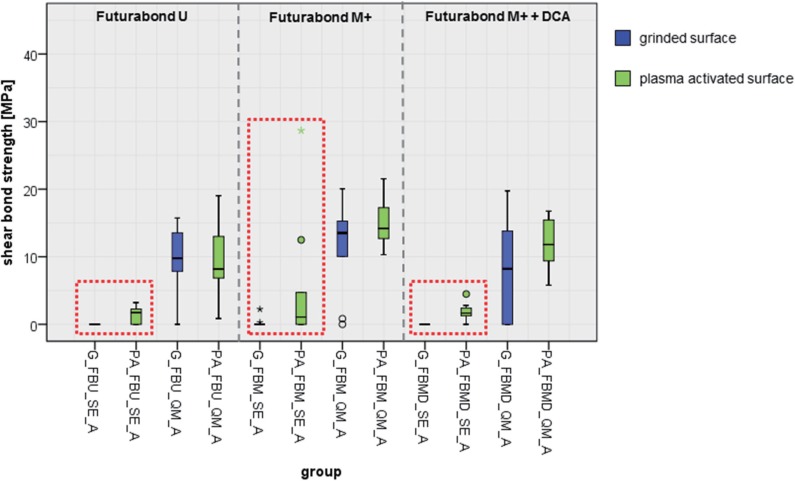J Adv Prosthodont.
2018 Aug;10(4):308-314. 10.4047/jap.2018.10.4.308.
Influence of nonthermal argon plasma on the shear bond strength between zirconia and different adhesives and luting composites after artificial aging
- Affiliations
-
- 1Department of Prosthetic Dentistry and Biomedical Materials Research, Hannover Medical School, Hannover, Germany. Pott.Philipp-Cornelius@mh-hannover.de
- KMID: 2418637
- DOI: http://doi.org/10.4047/jap.2018.10.4.308
Abstract
- PURPOSE
Plasma activation of hydrophobic zirconia surfaces might be suitable to improve the bond strength of luting materials. The aim of this study was to analyze the influence of nonthermal argon-plasma on the shear bond strength (SBS) between zirconia and different combinations of 10-MDP adhesive systems and luting composites after artificial aging.
MATERIALS AND METHODS
Two hundred forty Y-TZP specimens were ground automatically with 165 µm grit and water cooling. Half of the specimens received surface activation with nonthermal argon-plasma. The specimens were evenly distributed into three groups according to the adhesive systems ([Futurabond U, Futurabond M, Futurabond M + DCA], VOCO GmbH, Germany, Cuxhaven) and into further two subgroups according to the luting materials ([Bifix SE, Bifix QM], VOCO GmbH). Each specimen underwent artificial aging by thermocycling and water storage. SBS was measured in a universal testing machine. Statistical analysis was performed using ANOVA and Scheffè procedure with the level of significance set to 0.05.
RESULTS
Surface activation with nonthermal plasma did not improve the bond strength between zirconia and the tested combinations of adhesive systems and luting materials. The plasma-activation trended to reveal higher bond strength if the self-etch luting material (Bifix SE) was used, irrespective of the adhesive system.
CONCLUSION
Plasma-activation seems to be suitable to improve bond strength between zirconia and self-etch resin materials. However, further research is necessary to identify the influence of varying plasma-parameters.
Figure
Reference
-
1. Rosentritt M, Behr M, Scharnagl P, Handel G, Kolbeck C. Influence of resilient support of abutment teeth on fracture resistance of all-ceramic fixed partial dentures: an in vitro study. Int J Prosthodont. 2011; 24:465–468. PMID: 21909489.2. Aladağ A, Elter B, Çömlekoğlu E, Kanat B, Sonugelen M, Kesercioğlu A, Özcan M. Effect of different cleaning regimens on the adhesion of resin to saliva-contaminated ceramics. J Prosthodont. 2015; 24:136–145. PMID: 24919532.
Article3. Kohorst P, Herzog TJ, Borchers L, Stiesch-Scholz M. Load-bearing capacity of all-ceramic posterior four-unit fixed partial dentures with different zirconia frameworks. Eur J Oral Sci. 2007; 115:161–166. PMID: 17451508.
Article4. Zhang Y, Lee JJ, Srikanth R, Lawn BR. Edge chipping and flexural resistance of monolithic ceramics. Dent Mater. 2013; 29:1201–1208. PMID: 24139756.
Article5. Chen L, Suh BI, Kim J, Tay FR. Evaluation of silica-coating techniques for zirconia bonding. Am J Dent. 2011; 24:79–84. PMID: 21698986.6. Külünk T, Külünk S, Baba S, Oztürk O, Danişman S, Savaş S. The effect of alumina and aluminium nitride coating by reactive magnetron sputtering on the resin bond strength to zirconia core. J Adv Prosthodont. 2013; 5:382–387. PMID: 24353874.
Article7. Pott PC, Stiesch M, Eisenburger M. Influence of 10-MDP adhesive system on shear bond strength of zirconia-composite interfaces. J Dent Mater Tech. 2015; 4:117–126.8. Pott PC, Stiesch M, Eisenburger M. Influence of artificial aging on the shear bond strength of zirconiacomposite interfaces after pretreatment with new 10-MDP adhesive systems. J Dent Mater Tech. 2016; 5:1–9.9. Koizumi H, Nakayama D, Komine F, Blatz MB, Matsumura H. Bonding of resin-based luting cements to zirconia with and without the use of ceramic priming agents. J Adhes Dent. 2012; 14:385–392. PMID: 22282752.10. Saker S, Ibrahim F, Ozcan M. Effect of different surface treatments on adhesion of In-Ceram Zirconia to enamel and dentin substrates. J Adhes Dent. 2013; 15:369–376. PMID: 23534029.11. Canullo L, Micarelli C, Bettazzoni L, Koçi B, Baldissara P. Zirconia-composite bonding after plasma of argon treatment. Int J Prosthodont. 2014; 27:267–269. PMID: 24905269.
Article12. Noro A, Kameyama A, Haruyama A, Takahashi T. Influence of hydrophilic pre-treatment on resin bonding to zirconia ceramics. Bull Tokyo Dent Coll. 2015; 56:33–39. PMID: 25765573.
Article13. Wu CC, Wei CK, Ho CC, Ding SJ. Enhanced hydrophilicity and biocompatibility of dental zirconia ceramics by oxygen plasma treatment. Materials (Basel). 2015; 8:684–699. PMID: 28787965.14. Tabari K, Hosseinpour S, Mohammad-Rahimi H. The impact of plasma treatment of Cercon zirconia ceramics on adhesion to resin composite cements and surface properties. J Laser Med Sci. 2017; 8:S56–S61.
Article15. dos Santos DM, Vechiato-Filho AJ, da Silva EV, Goiato MC, Cesar PF, Rangel EC, da Cruz NC. Aging effect of atmospheric air on zirconia surfaces treated by nonthermal plasma. J Adhes Dent. 2015; 17:413–419. PMID: 26525005.16. Casucci A, Mazzitelli C, Monticelli F, Toledano M, Osorio R, Osorio E, Papacchini F, Ferrari M. Morphological analysis of three zirconium oxide ceramics: Effect of surface treatments. Dent Mater. 2010; 26:751–760. PMID: 20471073.
Article17. Denry IL, Holloway JA. Microstructural and crystallographic surface changes after grinding zirconia-based dental ceramics. J Biomed Mater Res B Appl Biomater. 2006; 76:440–448. PMID: 16184529.
Article18. Kawai Y, Uo M, Wang Y, Kono S, Ohnuki S, Watari F. Phase transformation of zirconia ceramics by hydrothermal degradation. Dent Mater J. 2011; 30:286–292. PMID: 21597215.
Article19. Nakamura T, Usami H, Ohnishi H, Takeuchi M, Nishida H, Sekino T, Yatani H. The effect of adding silica to zirconia to counteract zirconia's tendency to degrade at low temperatures. Dent Mater J. 2011; 30:330–335. PMID: 21597219.
Article20. de Gee AF, Feilzer AJ, Davidson CL. True linear polymerization shrinkage of unfilled resins and composites determined with a linometer. Dent Mater. 1993; 9:11–14. PMID: 8299861.
Article21. Göstemeyer G, Jendras M, Dittmer MP, Bach FW, Stiesch M, Kohorst P. Influence of cooling rate on zirconia/veneer interfacial adhesion. Acta Biomater. 2010; 6:4532–4538. PMID: 20601242.
Article22. Ernst CP, Aksoy E, Stender E, Willershausen B. Influence of different luting concepts on long term retentive strength of zirconia crowns. Am J Dent. 2009; 22:122–128. PMID: 19626977.23. Lindgren J, Smeds J, Sjögren G. Effect of surface treatments and aging in water on bond strength to zirconia. Oper Dent. 2008; 33:675–681. PMID: 19051861.
Article24. Ozcan M, Nijhuis H, Valandro LF. Effect of various surface conditioning methods on the adhesion of dual-cure resin cement with MDP functional monomer to zirconia after thermal aging. Dent Mater J. 2008; 27:99–104. PMID: 18309618.25. Valverde GB, Coelho PG, Janal MN, Lorenzoni FC, Carvalho RM, Thompson VP, Weltemann KD, Silva NR. Surface characterisation and bonding of Y-TZP following non-thermal plasma treatment. J Dent. 2013; 41:51–59. PMID: 23044388.
Article26. Park C, Yoo SH, Park SW, Yun KD, Ji MK, Shin JH, Lim HP. The effect of plasma on shear bond strength between resin cement and colored zirconia. J Adv Prosthodont. 2017; 9:118–123. PMID: 28435621.
Article27. Liu T, Hong L, Hottel T, Dong X, Yu Q, Chen M. Non-thermal plasma enhanced bonding of resin cement to zirconia ceramic. Clin Plasma Med. 2016; 4:50–55. PMID: 28239541.
Article28. Henningsen A, Smeets R, Heuberger R, Jung OT, Hanken H, Heiland M, Cacaci C, Precht C. Changes in surface characteristics of titanium and zirconia after surface treatment with ultraviolet light or non-thermal plasma. Eur J Oral Sci. 2018; 126:126–134. PMID: 29336070.
Article29. Kitayama S, Nikaido T, Takahashi R, Zhu L, Ikeda M, Foxton RM, Sadr A, Tagami J. Effect of primer treatment on bonding of resin cements to zirconia ceramic. Dent Mater. 2010; 26:426–432. PMID: 20102781.
Article30. Foxton RM, Cavalcanti AN, Nakajima M, Pilecki P, Sherriff M, Melo L, Watson TF. Durability of resin cement bond to aluminium oxide and zirconia ceramics after air abrasion and laser treatment. J Prosthodont. 2011; 20:84–92. PMID: 21284762.
Article
- Full Text Links
- Actions
-
Cited
- CITED
-
- Close
- Share
- Similar articles
-
- Nonthermal plasma on the shear bond strength of relining resin to thermoplastic denture base resin
- Shear Bonding Strength of Three Cements Luted on Pediatric Zirconia Crowns and Dentin of Primary Teeth
- Evaluation of the bond strength between aged composite cores and luting agent
- A comparative study of the shear bond strength of different ceramic brackets and adhesives
- Influence of sandblasting and primer on shear bond strength of resin cement to zirconia





